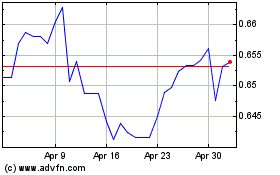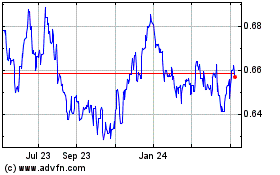Dollar Falls On Expectations For More Fed Rate Cuts
March 05 2020 - 4:42AM
RTTF2
The U.S. dollar came under pressure against its major
counterparts in the European session on Thursday, as markets are
pricing in another rate cut from the Fed at the March meeting after
its surprise reduction this week.
The Fed is expected to deliver another 25 bps cut at its March
17-18 meeting to counter coronavirus impact.
The central bank has already implemented an emergency
50-basis-point cut on Tuesday, taking the federal-funds rate to
between 1 percent and 1.25 percent.
Rise in coronavirus infections in the U.S. and the declaration
of a medical state of emergency in the state of California dampened
sentiment.
In economic news, the Labor Department released a report showing
a modest decrease in first-time claims for U.S. unemployment
benefits in the week ended February 29th.
The report said initial jobless claims edged down to 216,000, a
decrease of 3,000 from the previous week's unrevised level of
219,000. Economists had expected jobless claims to slip to
215,000.
Meanwhile, revised data released by the Labor Department showed
U.S. labor productivity increased by less than initially estimated
in the fourth quarter of 2019.
The report said labor productivity climbed by 1.2 percent in the
fourth quarter compared to the previously reported 1.4 percent
jump. Economists had expected the pace of productivity growth to be
unrevised from the initial estimate.
The Labor Department also said unit labor costs rose by 0.9
percent in the fourth quarter, reflecting a notable downward
revision from the originally reported 1.4 percent spike. The
increase in labor costs was also expected to be unrevised.
On Friday, the Labor Department is scheduled to release its more
closely watched employment report for the month of February.
Employment is expected to increase by about 175,000 jobs in
February after jumping by 225,000 jobs in January, while the
unemployment rate is expected to hold at 3.6 percent.
The greenback dropped to a 2-day low of 1.1200 against the euro,
from Wednesday's closing value of 1.1134. The greenback is likely
to challenge support around the 1.14 mark.
Survey data from IHS Markit showed that Germany's construction
sector grew for a sixth consecutive month in February to its
strongest level in over two years, led by a robust residential
building activity and an improving commercial activity sector.
The IHS Markit Germany Construction Purchasing Managers' Index,
or PMI, rose to 55.8 from 54.9 in January. The latest reading was
the best since January 2018.
The USD/CHF pair hit 0.9510, a 2-year low. The greenback is seen
finding support around the 0.94 area.
The greenback depreciated to a 5-month low of 106.80 against the
yen, from a 2-day high of 107.74 seen at 6:45 pm ET. Versus the
pound, it dropped to a weekly low of 1.2936. Further downside, the
support is possibly located near 104.00 against the yen and 1.31
versus the pound.
In contrast, the greenback rebounded to 0.6591 against the
aussie and 0.6287 against the kiwi, from its early multi-day lows
of 0.6637 and 0.6334, respectively. The next likely resistance for
the greenback is seen around 0.64 against the aussie and 0.60
against the kiwi.
The greenback was higher against the loonie at a 3-day peak of
1.3433. If the greenback gains again, 1.36 is possibly seen as its
next resistance level.
The U.S. durable goods orders for January are scheduled for
release at 10:00 am ET.
AUD vs US Dollar (FX:AUDUSD)
Forex Chart
From Mar 2024 to Apr 2024

AUD vs US Dollar (FX:AUDUSD)
Forex Chart
From Apr 2023 to Apr 2024
